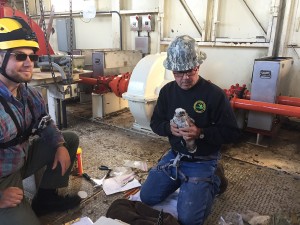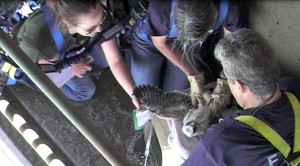Fast facts:
- A pair of peregrine falcons has successfully nested on the Portage Lake Lift Bridge again this year after completion of a major bridge repair project.
- Another pair of the endangered falcons successfully nested on the Sault Ste. Marie International Bridge, where the birds have been returning for years.
- The DNR banded four chicks at the Portage Lake Lift Bridge and three at the International Bridge.
June 28, 2016 — It’s been a good season for Upper Peninsula bridges and their resident raptors, with peregrine falcons at the Sault Ste. Marie International Bridge successfully hatching three chicks and the Portage Lake Lift Bridge between Houghton and Hancock seeing four hatchlings this spring.
At the Portage Lake Lift Bridge, the Michigan Department of Transportation (MDOT) installed two nest boxes in 2012 – one each on the north and south bridge towers. A pair of falcons discovered the nesting site the next spring and has raised a total of 10 chicks there.
MDOT took precautions to shield the lift bridge nesting boxes from construction work – an $8.4 million upgrade and preventive maintenance project started in late 2014 and just wrapped up this spring. Screens were placed to keep the falcons from seeing workers in the bridge machinery rooms and efforts were made to minimize disturbances in the nest area. During construction, a webcam, viewable at http://pasty.com/nestbox.html, was also installed in cooperation with the Copper Country Audubon Society to allow people to watch nesting activity.

On the eastern end of the U.P., Karl Hansen, bridge engineer for the International Bridge Administration (IBA), reported that a pair of peregrine falcons successfully nested atop the bridge between the U.S. and Canada this spring, hatching three chicks.
The hatching is the culmination of an ongoing commitment by the IBA. Nest boxes for the peregrines have been installed since 2010 on both the U.S. and Canadian arches. Peregrines have been active at the International Bridge since 1999 but, before the nest boxes were installed, the falcons laid their eggs in gravel on the exposed pier top – and there were unfortunate instances of eggs and chicks being blown off.
The same pair of adults has been returning to the U.S. side nest each year but, so far, none have taken up residence in the nest box at the Canadian arch. Hansen has counted 20 chicks hatched out of the nest boxes since they were installed.

The chicks at the Lift Bridge were banded by a Michigan Department of Natural Resources (DNR) team on June 17, while the International Bridge birds were banded by a team on June 20. According to DNR wildlife biologist Kristie Sitar, color-coded bands attached to the legs of young birds allow scientists to track the movements, reproductive behavior and population growth of the falcons. DNR biologists have yet to confirm that birds banded at either bridge have gone on to breed elsewhere, but that’s not unusual.
“There are no records of where fledged birds from (the IBA) site have gone but that doesn’t mean they aren’t breeding someplace,” Sitar said of the IBA birds. “Oftentimes, birds aren’t uniquely identified at new sites for a few years.”

In addition to their leg bands, the peregrine chicks received names. Names are typically assigned by DNR and bridge staff involved in the banding. At the IBA, names were chosen to honor the struggles of current and former colleagues battling cancer. The males were called Jim and Cameron, while the lone female was named Cheryn. At the Lift Bridge, DNR and bridge staff chose to name the females Lynn and Spunky, while the males were dubbed Edgar and Scottie. The new peregrines at both bridges should be ready to leave the nest in another few weeks.
The peregrine falcon has been removed from the federal endangered species list, but is listed as an endangered species in Michigan, protected by state and federal law. Peregrines have adapted to city habitats, nesting on tall buildings, smokestacks and bridges around the world. Studies have found the birds in this region tend not to nest in the same area where they were hatched, but spread out across the Midwest.
Every nesting site is special – in 2015, there were only 34 active nest sites in the entire state, with 29 of them on artificial structures. Only two of the five natural sites were accessible for banding birds this year, so having boxes on accessible structures like the Lift Bridge and International Bridge helps the DNR follow the raptor’s comeback.
High-speed hunters capable of flying at 200 mph, the peregrines may help keep populations of nuisance pigeons under control. While researchers have found pigeons make up a relatively small portion of the falcon diet, the dangerous predators may play a role in frightening them away from bridges. Keeping pigeons away is seen as potentially saving MDOT and the IBA maintenance money down the line, as pigeon droppings can damage paint on metal bridge surfaces.

###
Download MDOT’s Mi Drive traffic information app: www.michigan.gov/drive
www.michigan.gov/drive | www.twitter.com/MichiganDOT | www.facebook.com/MichiganDOT
CONTACT: Dan Weingarten, MDOT Office of Communications, 906-485-6322, ext. 136
A video of falcon banding operations at the Portage Lake Lift Bridge is also online – https://www.periscope.tv/w/1YqKDVYqBdvJV

